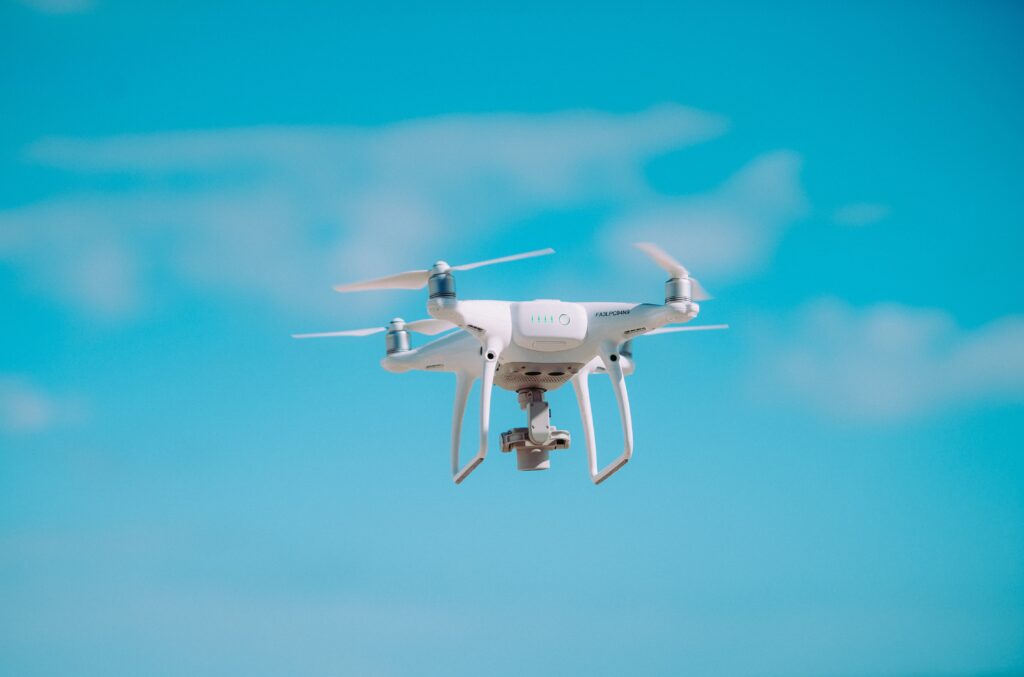The United States Court of Appeals for the Fifth Circuit recently issued an opinion in National Press Photographers Association v. McCraw, a lawsuit challenging the constitutionality of Texas’ drone privacy law. [Read Opinion here.]

Photo by Annie Spratt on Unsplash
Statutory Background
In 2013, the Texas Legislature passed the Texas Privacy Act, Chapter 423 of the Texas Government Code (“Chapter 423”). The purpose of this statute was to regulate the use of drones in Texas airspace. [To read full summary of the law, click here.] Essentially, Chapter 423 can be divided into two sections: the Surveillance provisions and the No-Fly provisions. Each of these sections carry the potential of criminal penalties and civil liability.
Surveillance provisions
The Surveillance provisions made it unlawful to use a drone to “capture an image” of a person on private property with an intent to “conduct surveillance” on that person or property. Then, the statute listed a litany of statutory exemptions to the Surveillance provisions. These include law enforcement and military operations, academic purposes, and real estate agent uses, for example. Note, there is no such exemption for uses of drones in this manner by the press.
No-Fly provisions
The No-Fly provisions made it illegal to fly a drone above certain facilities. These included “critical infrastructure facilities,” like airports, refineries, large sports venues, and confined animal feeding operations. A person violates this law if they intentionally or knowingly operate a drone over a critical infrastructure facility at less than 400′ above the ground, allow a drone to make contact with a critical infrastructure facility (including a person or object on the premises), or allow a drone to come close enough to a critical infrastructure facility to interfere with the operations of or cause a disturbance to the facility. Again, there were a number of exceptions to the No-Fly provisions as well, including one that allows an operator to violate the provisions if it is done “for a commercial purpose” so long as the operator complies with all Federal Aviation Administration (FAA) regulations. And, again, there was no similar exception for the press.
Lawsuit
Three Plaintiffs–one drone-owning journalist and two media-related organizations–filed suit against a number of state officials claiming Chapter 423 is unconstitutional. [Read blog post on lawsuit here.] Specifically, they filed a facial constitutional challenge to the statute. This means they challenged Chapter 423’s constitutionality on its face, rather than based on its application to a specific set of facts. They asserted that the Surveillance provisions violate the First Amendment and the Due Process Clause and that the No-Fly provisions violate the First Amendment, Due Process Clause, and federal preemption principles. In summary, they claimed that Chapter 423 infringes on their constitutional rights to film and gather news, that the statutory language is so vague it violates Due Process, and that Texas has no authority to pass such laws because the federal government has expressly preempted such state laws.
The United States District Court for the Western District of Texas found in favor of the Plaintiffs. [Read blog post on that decision here.] The court dismissed the federal preemption claim but ruled in favor of the Plaintiffs on all of their remaining theories. The court entered an injunction prohibiting Texas from enforcing Chapter 423.
Both sides appealed. The Defendants argued the lower court was wrong on the merits, but also challenge the Plaintiffs’ standing and claim the state should have sovereign immunity in this case. The Plaintiffs argued the court should have found in favor of their preemption claim as well.
Appellate Court Opinion
On October 23, 2023, the United States Court of Appeals for the Fifth Circuit issued its opinion reversing the lower court and finding in favor of the State of Texas. [Read Opinion here.] The court’s opinion can be divided into four sections.
I. Standing
The State of Texas argued that Plaintiffs lacked standing to bring this case. For the Plaintiff organizations, the standing requirement at issue was whether the organizations’ members would have standing to sue in their own right. For the individual Plaintiff, the questions at issue were whether he suffered an injury in fact and whether that injury is fairly traceable to the challenged action of the Defendants. The Plaintiffs bear the burden of proving standing.
Injury in Fact
An injury sufficient to satisfy the standing requirements must be concrete and particularized and actual or imminent. Such injuries cannot be hypothetical. The allegation of a future injury may be sufficient if the threatened injury is impending, or there is a substantial risk the harm may occur.
The State argued the Plaintiffs have no injury as no one has ever been prosecuted or arrested for violating Chapter 423, including the Plaintiffs. The Plaintiffs claimed the threat of enforcement is the injury. They claimed that they have ceased using their drones in news gathering activities due to the penalties they could face for doing so under Chapter 423.
Due Process Claims
First, the court looked at the issue of standing to bring a Due Process claim. The court sided with the Defendants, dismissing the Due Process claims. The court noted that none of the Plaintiffs or their members have ever been arrested or prosecuted for violating Section 423. Thus, the issue of whether Chapter 423’s provisions are unconstitutionally vague is “a mere hypothetical dispute lacking the concreteness and imminence required by Article III.” The court held that without “an imminent or even credible threat of prosecution under Chapter 423,” the Plaintiffs lack standing to preemptively challenge the statute under the Due Process Clause. Thus, the court vacated the trial court’s judgment on the due process claims.
First Amendment Claims
Next, the court turned to standing to bring the First Amendment claims. The standard for these claims is different because the law recognizes more “relaxed” standing rules in First Amendment cases by allowing prospective relief for citizens whose speech might be chilled by fear of sanction. In order to satisfy the chilled speech injury required for standing under the First Amendment, a plaintiff must show that they had an intent to engage in a course of conduct arguably affected with a constitutional interest, the intended conduct is arguably proscribed by the law in question, and the threat of future enforcement of the law is substantial.
Here, the Plaintiffs offered evidence that some Plaintiffs stopped using their drones in newsgathering activities due to potential Chapter 423 penalties. Another noted that he still uses his drone generally, but not if law enforcement is present because of Chapter 423. Plaintiffs testified that they had lost the opportunity for profit due to their inability to use drones per Chapter 423. Certain newspapers enacted policies prohibiting photographers from gathering footage using drones. This policy was reversed after the trial court issued an injunction prohibiting enforcement of Chapter 423.
The State responded that they have never enforced Chapter 423, so Plaintiffs offered a merely subjective chilling concern, not an objective concern.
The court found the Plaintiffs’ injuries–the chilling effect of Chapter 423 and the monetary losses sufficient to show the required injury in fact. The court held that the fact that the statute has not yet been enforced does not preclude standing. This is particularly true, the court noted, “when, as here, the State has not disavowed any intention of invoking the law against Plaintiffs.”
Traceability
Even if the Plaintiffs have suffered an injury, they must also show that their injury is fairly traceable to the Defendants’ conduct. Here, the Plaintiffs must show the injuries they suffered were caused by the State of Texas Defendants. The court found traceability with regard to DPS and the State Highway Patrol Defendants as they are tasked with enforcing laws protecting public safety. The court also found traceability with regard to a District Attorney Defendant, as he is charged with prosecuting individuals who violate criminal laws.
In light of this, the court found the Plaintiffs may bring their claims challenging the criminal penalties of Chapter 423 against these Defendants. They may not, however, sue these Defendants to enjoin the civil penalties because they do not enforce such provisions. Only private individuals harmed by the civil provisions may enforce those provisions. Thus, the court lacked jurisdiction to order the Defendants not to enforce the civil portion (Chapter 423.006) of the statute and that portion of the injunction is vacated.
Sovereign Immunity
The court turned next to the issue of sovereign immunity. Generally, States are immune from lawsuits under the doctrine of sovereign immunity. This doctrine also prohibits lawsuits against state officials or agencies that are effectively lawsuits against the State. There is, however, an exception to this prohibition from suit called Ex Parte Young which allows a plaintiff to sue a state officer in his or her official capacity for an injunction to stop ongoing violations of federal law. In order for this type of lawsuit to be allowed, the state official must have “some connection with the enforcement of the challenged act.” The court has developed a three part test to guide the analysis of whether a sufficient connection exists: (1) official must have more than a general duty to see that the laws of the state are implemented; (2) official must have the particular duty to enforce the statue in question and demonstrated willingness to exercise that duty; and (3) enforcement means compulsion of constraint.
The court found the first and third elements easily met. The second–a willingness to exercise such duty–is missing for two of the named Defendants. The court noted that DPS or the State Highway Patrol never issued a warning or citation for violation of Chapter 423 in the decade it has been the law. Thus, there is zero evidence that either the Director of DPS or the Chief of the Highway Patrol have shown a willingness to exercise their duty, and they are both entitled to sovereign immunity.
The same is not true for the third Defendant, the Hays County District Attorney because he is a county official, not a state official. The court previously held that District Attorneys are not protected by sovereign immunity and held the same here.
Merits of the Case
Next (finally), the court reached the merits of the case, addressing the Plaintiffs’ First Amendment claims first and then their preemption claim.
First Amendment
The court addressed the two sections of the statute separately.
No-Fly provisions
The court found in favor of the Defendants on this claim. The Plaintiffs’ claims fail because only “inherently expressive conduct” receives First Amendment protections. The operation of a drone is not inherently expressive. Neither is it expressive to fly a drone over a sports venue or critical infrastructure facility. “Nothing in the No-Fly provisions have anything to do with speech or expression. They are flight restrictions, not speech restrictions.”
The court rejected the Plaintiffs’ argument that drones are often used for photography, which is expressive conduct. The court quoted a prior US Supreme Court decision holding that “the right to speak and publish does not carry with it the unrestrained right to gather information.”
Because the No-Fly provisions have nothing to do with speech or expressive activity, they do not implicate the First Amendment. The district court’s opinion is reversed.
Surveillance provisions
The court noted that, unlike the No-Fly provisions that are mere flight restrictions, the Surveillance provisions make capturing certain images unlawful. Restrictions on filming have been found to implicate the First Amendment. The extent of the constitutional protections for the right to film is an ongoing debate. The court sited several cases, including a recent US Court of Appeals for the Fourth Circuit decision finding First Amendment rights for animal rights activists to infiltrate businesses and film them and a US Court of Appeals for the Ninth Circuit decision finding a law prohibiting secret recording of conversations violates the First Amendment. The leading Fifth Circuit case on this issue is Turner v. Lieutenant Driver, where the court held that the First Amendment protects the right to record the police doing their public duties in public places. The court noted, however, this right is not unlimited. Thus, the court here held that the right to film is subject to some level of First Amendment scrutiny.
How much scrutiny should apply was the next question. The court held that intermediate scrutiny was the proper level for this case. Under intermediate scrutiny, a content-neutral law will be upheld if it furthers an important governmental interest that is unrelated to the suppression of free expression and if the incidental restriction on First Amendment freedoms is no greater than necessary to further that governmental interest.
The court held that the State has a substantial interest in protecting the privacy rights of its citizens. The law is limited to only prohibit certain filming activities–those at a height above 8 feet on private property. This distinction between public and private places is critical to the court’s decision. Thus, the law survives intermediate scrutiny, the lower court is reversed, and the law is upheld.
Preemption
Plaintiffs claimed the trial court erred in dismissing their preemption claim that the No-Fly provisions are preempted by federal regulation of airspace. The court found this claim to fail on the merits. Field preemption occurs when Congress has essentially determined a certain area must be regulated by federal law, thereby prohibiting State regulation. Even when there is no express preemption, it may be inferred from a “scheme of federal regulation so pervasive as to make reasonable the inference that Congress left no room for the States to supplement it, or where an Act of Congress touches a field in which the federal interest is so dominant that the federal system will be assumed to preclude enforcement of state laws on the same subject.”
Here, the court held the Plaintiffs failed to show that Congress or the FAA intended to occupy the entire field of drone regulation. Although there are some federal regulations, there is no evidence federal law has completely preempted the field regarding drones. In fact, the FAA expressly declined to do so stating that it would not expressly preempt state law and noting that State law offers legal protections related to privacy and drone usage.
Conclusion
The court’s conclusion began with the following language, ” Plaintiffs picked an uphill battle by styling this litigation as a facial, pre-enforcement challenge.” Importantly, the court noted this decision does not foreclose all First Amendment and Due Process challenges to Chapter 423. It is possible that an as-applied challenge under certain facts may be successfully pursued. But on a facial challenge, the Plaintiffs’ claims fail.
Thus, the court affirmed the dismissal of Plaintiffs’ preemption claims and vacated the remaining portions of the district court order.
Potential Reconsideration/Appeal
The Plaintiffs have filed a motion for en banc hearing. This means they want the all of the US Court of Appeals for the Fifth Circuit judges to hear the case, rather than just the three-judge panel that issued this opinion. If that is denied, the Plaintiffs could also file a Petition for Certiorari with the United States Supreme Court. In various news articles, they have said they are weighing their options.
Key Takeaways
This is an important decision with regard to drone usage in Texas. Although the focus of this lawsuit is on the First Amendment and the Constitutional rights of those seeking to use drones, do not forget that the statute offers privacy protections for landowners as well. Rural landowners and agricultural producers could find themselves on either side of the issue and many producers and agribusinesses use drones in their operations, but many others have complained about drone use on private property. It is an area of the law where technology got out front and the law has been forced to play catch up for many years.


















